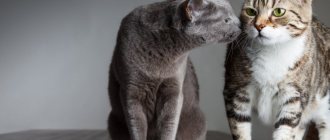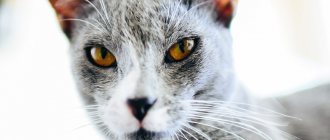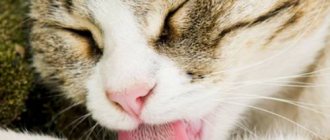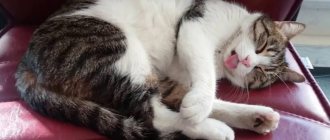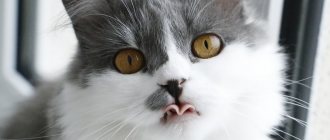Cats have many ways of interacting with each other, and to properly understand animals, it is important to know how they communicate and why. For example, at the initial stages of aggression, representatives of the cat family avoid direct gazes, because This is seen by them as a sign of a militant attitude. This is one of the reasons why cats often choose people who do not show interest in them.
How cats talk to people
Science has long been trying to study cats, but they are reluctant to participate in experiments and various types of research. Researchers prove that our four-legged furry creatures came to Europe from Egypt. But there is another version that the domestication of cats occurred in Nubia more than 3 thousand years ago from a North African cat. Only later did they appear in Egypt and Asia.
You can understand a cat's language by observing your pet.
Cats were respected and endowed with superpowers. The ancient Greeks, who brought cats into the country illegally, were immensely grateful to them for their fight against rodents and even made the cat a symbol of the Spartacus uprising. In Egypt, cats were used not only to fight mice and rats, to protect crops, they were trained to hunt birds, hares, and moles. The Egyptians elevated them to the rank of deity, whom they worshiped. Mummies of cats were found in the burials of ancient Egyptians along with the mummies of nobles.
Peaceful cat
In Rus', cats served in Orthodox churches, art galleries, palace chambers, and bazaars. The cost of the first cats brought to Russia was equal to the cost of an ox and amounted to 200 grams of silver. Cats are still in service in the Hermitage. Each of them has their own personal bowl, place to sleep, and veterinary documents.
Important! The only animal that is allowed to enter the temple freely is a cat.
People love their furry pets so much that they even decided to make March 1st World Cat Day. True, it has not been officially approved anywhere, but lovers of their fluffies all over the globe on this day show them all respect, honor and gratitude for their existence, for their fight against rodents.
Sign language: what does the tail, paws, ears, posture mean?
Cats do not speak human language; cat language causes confusion in humans. But if you try and observe our smaller brothers, their facial expressions and behavior, you can learn to understand cat sign language.
Aggression in cats can be caused not only by their dissatisfaction; perhaps they are worried about something, are alarmed, and seek protection from the owner. They cannot draw attention to themselves in any other way, it doesn’t work.
Note! If you look at a cat under a “microscope,” then its body language can say a lot.
The position of an animal's tail can also tell a story. For example, a peacefully resting cat begins to nervously move its tail from side to side when its owner approaches. This suggests that something is bothering him, he is alarmed, nervous. If only the very tip of the tail moves, it means that the anxiety is minor or the pet is falling asleep.
A tail raised to the top tells of the dominance of a given individual over others or shows the alertness of the animal. Sharp swings of the tail from side to side indicate extreme irritability of the pet, its dissatisfaction, and a warning of an attack. In this case, it is better to leave him alone until he calms down.
For your information! Animals can greet each other with their tail raised. A tail hanging down indicates that the pet is hungry, thirsty, or dissatisfied with something.
Cats attract the owner's attention with a soft touch of their paw pads when they are hungry, thirsty, or ask to be petted. They can hug the owner’s arms or legs, grab the edge of clothing, or climb up pants with their claws.
To attract attention, cats go to different lengths
Stomping all over their owner, their claws slightly extended, as if giving a massage, the fluffies succumb to the instinct associated with childhood, when they received their mother's milk by massaging her breasts. That is, there is recognition of a loved one, a feeling of security, safety.
The language of cats in the form of a raised paw tells of concentration, the desire to understand the unknown, caution, and a state of shock. Having dealt with the incomprehensible, the animal dies.
Facial language: smile or grin
The downward whiskers indicate that something is wrong with the kitten, perhaps he is not feeling well, he is dissatisfied with something, or irritated. Licking that is not related to food indicates nausea or thus shows concern or interest in something.
Their muzzle, like a human face, can express a serene mood, satisfaction, or vice versa, fear and aggression. A smile expresses a good mood, and a bared mouth warns of the threat of an attack.
A cat sitting with his tongue hanging out and his mouth slightly open means that he is focused on hunting for a mouse, or he is hot, or he was caught stealing from a table. It looks pretty funny, unless of course it is a disease.
Sad face with drooping mustache
What does attention to the ears mean?
A cat mood phrasebook can be compiled based on the position of the ears. Ears directed forward tell about the pet’s good mood, its peace, calmness, and readiness to make contact. Ears turned in different directions indicate that the animal is worried, does not know how to behave, and is showing interest in something or someone.
But ears pressed to the head or sticking out back warn of impending danger. The pet is alarmed, afraid of something, ready to attack at any moment. By twitching their ears, cats are trying to say that they are nervous, anxious or don’t like being scolded for their offense; they are not inclined to communicate at the moment.
Body poses
Unable to express their emotions in words, cats try to show it through their body postures. Approaching the owner, the fluffy ball shows its affection towards him by dancing its body. He presses himself to the legs, stands on his hind legs, rises and falls, showing his love in every possible way.
The stomach of any animal is the most vulnerable, least protected part of the body. If the cat lies down on its back, exposing its tummy for stroking, it means that it trusts the person immensely, feeling completely safe. He is sure that he will not be harmed or hurt.
Additional Information! If an attempt to stroke the animal’s tummy causes a protest, it means that the cat is simply scratching its back and is not waiting for affection from the outside.
Pose when the pet likes everything
Voice signals
How to understand a cat, what he is trying to say when he meows, can be determined by observing him from the side. By meowing, a cat can notify that it has gone to the litter box, is hungry, asks to be let out into the street or let into the house, simply in this way expresses its emotions. With a hiss, she warns of an attack, expressing her dissatisfaction, fear, and aggression.
Important! A cat finds her kittens to nurse by the vibrating sound they make immediately after birth. This habit of attracting attention when they are hungry continues into adulthood.
Cats purr loudly when demanding food and while eating it. The tonality of the rumbling differs in different cases. The hungry rumbling-meowing of a lost or abandoned kitten resembles the crying of a baby.
Loving mother and kitten
What does friction against the owners mean in cat language?
If a mustachioed pet rubs against the legs, arms or face of the owner, he expresses his declaration of love to him. By touching a person's lips with a wet nose, the animal seems to kiss him and express his gratitude.
There are now many videos on social media apps showing cats talking to their owners. The cat talks like a person, can respond to the inconvenience caused to him, there is a conversation between two cats sharing territory. All these videos can be viewed and are free to download. It turns out that getting them to talk is not as difficult as it seems. A cat can be made to learn a few words or phrases in human language.
If a cat rubs against its owner, it shows its love.
What does a cat want to say with a gentle purr?
Purring shows that the cat is good, comfortable, happy with everything, loves and is loved. But sometimes rumbling can express pain, nervousness, and fear. According to veterinarians, cats purr when they die when they are euthanized.
There is an opinion that the rumbling of an animal helps relieve stress and rejuvenates tissues. The frequency of 25-100 Hz, at which purring occurs, is used in many therapeutic devices in physiotherapy rooms. At a frequency of 25-50 Hz, bones grow together better, and at a frequency of 100 Hz, soft tissues and skin are healed.
What does a cat's screams mean?
When bringing a cat into the house, many expect only a joyful purr from it on their lap. But each animal has its own difficult character. When it has any desires or problems, it can express them with such a loud cry that can be heard several kilometers away.
A pet will not scream for no reason, there is always an explanation for this. Most often, the reason to shout is sex hormones, which begin to act with the onset of spring. The language of cats notifies the circle of his desire to have a cat.
Additional Information ! An unsatisfied cat may demand a cat up to 10 times a year. The cat gets excited every time he feels the female’s sexual secretion.
Failure to satisfy sexual needs negatively affects the physical and mental state of the animal. To satisfy their physiological needs, cats place marks in the apartment, try to escape outside, and howl heart-rendingly. With their screams they try to attract mating partners.
Redistribution of territory
A pet's cry may mean dissatisfaction with changes in his life. This could be moving to a new place of residence, the appearance of a new pet in the family or the loss of an old one, or a change of owner. The animal expresses its dissatisfaction with circumstances, stress from what is happening, and uncertainty about the future by screaming.
Visual cues
External manifestations play a big role in conveying mood and intentions. Animals use body posture, facial expression, pupil size, and changes in fur position as visual signals. However, compared to wolves and dogs, cats' faces are immobile, which limits the cats' expressive abilities.
The position of the tail is one of the most informative visual signals. The “tail up” position, when this part of the body is raised in the air and located perpendicular to the ground, indicates a friendly attitude of the cat approaching its relative, another animal or person. At the same time, the cat's ears will be perked up and the whiskers will be relaxed.
The aggressive attitude of the pet is demonstrated by an elongated tail, slowly moving from side to side. In more extreme situations, the animal raises its fluffy tail, while the fur along the spine can also take on a vertical position - in this way the animal tries to look larger.
Visual cues are not limited to tail position. To express mood and intentions, facial expressions (especially movements of the eyes and mouth), position of the ears and body are no less important. A cat whose ears are raised and turned, and whose pupils are constricted or reduced in size, usually experiences anger or aggression, while a pet with dilated pupils and ears pressed to the head is afraid. If the animal is calm and in a state of comfort, its ears are facing forward and in a normal position.
The arched back of the animal is a sign of self-defense. A cat taking a defensive position squats, “shrinks,” and hits the ground with its tail. If your pet is stretching out, he is probably feeling confident, but in some cases it can be a sign of aggression and readiness to attack.
Eye contact is important during animal interactions. A fixed gaze with a slight blink is a challenge to the opponent, while a relaxed gaze with half-closed eyes is a sign of satisfaction.
A tense and alert cat will have its whiskers fanned out and directed forward in front of its muzzle. When the pet is relaxed, the whiskers are straight and slightly apart. The mustache gathered together, pressed to the sides of the muzzle, will tell about nervousness and fear.
There are many other visual cues that are found in cats, but not all of them lend themselves to clear interpretation. Thus, scratching vertical surfaces is associated with the desire to mark territory, however, it has been noticed that pets “tear” objects located on the cat’s path inside the house, but do not do this in other places. Many animals periodically roll over onto their backs, showing off their bellies. This behavior also remains not fully understood, but is presumably associated with a friendly and submissive attitude.
Can a cat understand a person?
How to make cats friends with each other in an apartment: examples of how to reconcile
Many cats, unlike dogs, live an independent life, coming into the house only for the purpose of sleeping in a safe place. Most existing cat breeds have been bred by breeders over the last hundred years. Until this time, selection aimed at identifying and consolidating special character traits had not been carried out.
For your information! Their understanding of a person is based on the benefit and comfort of their loved one.
If the inhabitants of the house are in a good mood, then the cat will get something tasty, they will caress it, stroke it, and sit it on their lap. If the owner is angry, upset, dissatisfied, he can yell at the pet, take it out on him, throw him out the door, and don’t even think about the treat. Therefore, the ability to understand a person’s mood and understand it is necessary for living comfortably together and for building relationships.
To understand a person, it is necessary, first of all, for the animal to perceive its owner as a companion. This perception is laid down in the kitten before it reaches eight weeks of age, when it has just begun to develop. The second stage of obedience and understanding of a person is to stimulate the baby to take the right action through praise and encouragement.
Education starts from childhood
Kittens raised in this way from early childhood, in adulthood, willingly make contact and communicate with people. They are able to recognize the owner by their steps, by their voice, understand sign language, feel the intonation of human speech, and can determine the mood of their companion by facial expressions and body posture.
Animals behave differently around strangers. They do not make contact with strangers, they are not interested in their emotions. To determine their reaction to a guest in an unclear situation, they rely on the emotions of their owner.
Meeting face to face
If you feel that your pets are ready to face each other, you can again use food as a distraction. Don't feed your cats for a while so that they are a little hungry, and then give them food in the same room at the same time. Choose a room where the cat could hide behind furniture or jump higher if it wanted. Let the first cat into the room, and then allow the second one to come out of the basket and eat. You will need to decide how close to get them together - don't try to get them as close as possible from the start. Be calm, encourage your pets and reward them for good behavior with praise, treats or their favorite food. Watch how your pets interact - they may find their own place and curl up to sleep, but you may need to keep the new cat away from the first one for a while, using feeding time as an opportunity for them to interact more closely. Once you're sure your pets won't fight or chase each other, you can give them access to the rest of the house. Most likely, they themselves will find a place for sleep and daily activities that would allow them to live peacefully in the same house and sufficiently enjoy all its benefits - warmth, food and your attention, while at the same time gradually getting used to each other.
Cats communicating with each other
Which dog breeds are often confused with each other?
How cats communicate with each other can be seen in stray animals. They form flocks around places where there is food. Often their colonies can be seen near shops, landfills, and veterinary clinics. Flocks have their own hierarchy; the cats' conversation boils down to caring for each other, caring for other people's kittens, and communicating with each other.
In scientific circles, it is generally accepted that cats do not communicate with each other through meowing. When communicating with each other, they use body language, facial expressions, and hissing. They may even greet fellow higher ranks by nodding their heads when they meet.
Colony of stray cats
With kittens, cat conversation comes down to “purring.” While licking each other, the cats purr with pleasure, showing with all their appearance how much they enjoy this procedure.
Vocal communication
Cats have a rich range of vocalizations. Their “vocabulary” is quite wide, which is associated with the nocturnal lifestyle of representatives of the cat family.
Vocal communications are used during:
- agonistic interaction;
- sexual relations;
- communication between mother and kittens;
- cat-human interaction.
In general, there are three main forms of vocal communication:
Mumbling
These sounds, made primarily with the mouth closed, are used by animals during greeting, attracting attention, confirmation and approval. This group of vocalizations includes purring, which is used in different types depending on situations.
When kittens purr in response to their mother's care, they thus communicate their satisfaction; The mother cat, in turn, makes these sounds to calm the cubs.
As adults, animals use this form of vocalization when greeting each other or asking for attention; Also, sounds reminiscent of muttering are used in allogrooming. It is assumed that by purring a cat signals to its relatives that it is not dangerous to them.
Domestic cats purr at a frequency of 25-150 vibrations per second.
All members of the cat family have the ability to purr, but large animals (lions, tigers, leopards and jaguars) do this only when exhaling.
The "trills" and "chirps" that can be heard during a friendly greeting also fall into the category of mumbling.
Meowing or vowel sounds
Cats have a wide range of meows, and these sounds are used to convey different types of information. Most often, this vocalization conveys a friendly attitude towards relatives, but it can also have other semantic meanings. Thus, kittens meowing in high tones indicate that they are hungry, and short high-pitched sounds coming from adults indicate their dissatisfaction.
Sounds of aggression
These sounds are pronounced by the animal with its mouth open. They can be described as growls, howls, hisses, screams and screams. Vocalizations accompany aggression, which manifests itself both during self-defense and during attack.
How to establish rapport with a cat
The cat shows its tongue: the main reasons and what it means
The cat-human relationship begins at an early age in the kitten. The more the owner communicates with his pet, the better the contact between them will be. In babies of the same litter, the difference in behavior is noticeable after only 10 days of interaction with a person.
How to talk to a cat can only be determined by your relationship with him, a trusting relationship, a dictionary of gestures, an understanding of the sound signals emitted by a four-legged pet, affection, and keeping some distance. One short meow indicates a greeting, and multiple meow-meows indicate joy at the appearance of the owner.
Having studied the language of the location of the ears, tail, body posture, and listening to the sounds made, it is not difficult to learn to understand your pet.
Body movements
The most visible part of a cat's body is its tail. It is he who expresses the cat's feelings and emotions most clearly. Only by the tail can one judge the cat’s states and intentions. The tail is raised up - your pet is in a good mood, friendly and ready to communicate. Kittens' puffy tails are a symbol of their interest in the world around them. A raised tail is a call to play.
If the tail, on the contrary, is lowered and tousled, this means that the animal is alert. But if the fur is raised only at the base of the tail, the cat already knows what to do in this situation. Severe fear is expressed by the tail tucked between the paws.
An aggressive animal can be recognized by a highly raised, tense, tousled tail in a dominant animal and a lowered, arched tail in subordinates. A horizontally extended tail twitching rhythmically is a sign of irritation, but if the tail is knocking on the floor, the cat is more likely to be scared. If the amplitude of movements increases, and the animal literally whips itself on the sides with its tail, this is pronounced aggression.
Depending on how fast and what part of the tail the animal moves, emotions are determined. For example, a slight waving of the tip of the tail indicates relaxation; at first, a slow, and then increasingly rapid swing of the tail occurs before jumping on the object of the hunt.
The cat's pose expresses its own state, and also depends on who it is addressed to. The pose when seeing a strong opponent is different from the pose with which a cat meets an aggressive fellow tribesman. The threat pose allows the cat to look larger and more impressive: the legs are extended, the animal stands on tiptoes, the back is arched, the tail is curved, the hair stands on end. In an excited or frightened cat, the cheek nodules move, the hair on the cheeks bristles. The threatening pose is complemented by ears pressed to the back of the head, the nose is wrinkled, the fangs are exposed, and the corners of the mouth are drawn back. The cat purrs and hisses.
Cats sense the threat distance well: the distance from the enemy to the cat that no longer feels safe. Usually the animal prefers to flee, although it takes a threatening pose. But if the cat is cornered and cannot escape, and the threatening pose has no effect and the enemy continues to approach, the cat rushes to attack. This distance is called the “distance of aggression.” But for a mother cat there is no difference between “threat distance” and “aggression distance”; she will not run, but sees the enemy from afar. The cat rushes towards the enemy, jumps on all four legs, straight and outstretched, while remaining turned sideways to the enemy, the tail is raised high and fluffed. Such a cat is ready to fight to the death to protect its offspring.
In relationships with aggressive fellow cats, cats use other postures. The animal practically does not hunch its back and does not bristle its fur, but only slightly fluffs it on the withers and tail. Distance is not particularly important; the animals stand nose to nose, looking into each other's eyes, howling and purring. Cats try to remain motionless in order to suppress the enemy's morale, but the blows of the tail on the sides mean that the animal is ready to rush into a fight at any second.
When the fight begins, the first blow with the paw lands on the opponent's nose. The attacker then tries to bite the back of the opponent's head, and if this succeeds, the opponent falls on his side. A cat that does not want to engage in a fight takes a pose that combines elements of submissiveness and threat: the animal presses into the floor, lies on its side or back, putting its paws forward with its claws extended. The winner of the fight is eliminated first, trying to retain as much dignity as possible.
When communicating with people, cats rarely carry out their threats. Animals have developed inhibitions that inhibit aggression towards the owner. But if the animal is threatened by a stranger, the cat will aggressively defend itself and can seriously injure the person.
The most graceful demonstration of contentment and complacency is when a relaxed animal lies down, showing an unprotected belly. The paws are spread out to the sides, the claws are hidden, the pads can be compressed and unclenched. The eyes are half-closed, the pupils are constricted. This pose demonstrates complete trust, since the stomach is the most vulnerable place on the body.
Cats show indecision in a very interesting way. This condition is always accompanied by licking of fur. The more decisively the cat licks itself, the more serious the problem it solves at that moment. Licking calms the animal, neutralizes irritability and possible aggression. Cats often lick their cubs, other animals and even their owners, showing their affection and calling for calm.
The emotions of the owners are transferred to the animals. Nervousness, tension, the appearance of a small child who makes the cat jealous can lead to pathological behavior of the animal, expressed in the fact that the cat licks itself until certain parts of the body are completely bald.

